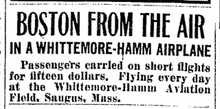By Janice K. Jarosz
(Editor’s Note: This is the fifth in a series of articles about the upcoming “Open House” event set for the first weekend in May at the old Cliftondale School – now known as The MEG – at 54-48 Essex St. in Saugus.)
Born in Roxbury, Mass., on Nov. 15, 1883, Harry Nelson Atwood became an American engineer and inventor known for pioneering work in the early days of aviation, including long-distance flying and delivering the first air mail drop from the Saugus Race Track, in Cliftondale, Mass.
On July 14, 1911, after only three months of training at the Wright Flying School in Dayton, Ohio, Harry flew a record-breaking 576 miles from Boston to Washington, D.C., landing on the White House lawn at the invitation of President Taft. He won a $10,000 prize by flying from Chicago to Milwaukee. Between August 14-28, 1911, he flew 1,256 miles from St. Louis to New York City, making 11 stops and spending 28 hours in the air. Atwood funded his flying activities with the sale of two different electric meters he designed to General Electric Company, and for the next three years, he served as the chief flight instructor at the Burgess Company – building a variety of planes.
The idea of building an aviation field on the site of the old Franklin Park Saugus Race Track in the Cliftondale section of Saugus, Mass., was first proposed in December 1910 by the Aeroplane Company of America. They agreed to spend $100,000 to convert the old race track into an airfield, a factory to manufacture flying machines and a flight school, but that deal fell through. Next the General Aviation Corporation purchased the Franklin Park Race Track and converted the property into an airfield and hired Atwood as an instructor, and it eventually became home to one of the busiest aviation schools in the country with 43 students.
Atwood flew his biplane over Portland, Maine, in May 1912, from Saugus, Mass. According to the newspaper, he came in low over the eastern part of town, then flew over the village “close enough to inspect the Dearborn monument.”
On May 31, 1912, Harry Nelson Atwood made the first New England Aeroplane airmail carrier trip in a biplane of his own design from the Atwood Racetrack in Saugus to Lynn. The pouch of mail contained 300 letters and 500 postcards. Soaring over a field near the River Works, the pouch was dropped on the Lynn Commons and was retrieved by a post office employee, who brought it to the Lynn Post Office – 12 minutes after leaving Saugus.
On June 10, 1912, Atwood quit his position at the Race Track, stating that he could make more money on exhibition flights, and on his way out, he took the schools’ only plane. As a result, the school closed, but shortly after the closing, Mr. Waite established a new aviation school.
On July 31, 1912, “Boy Aviator” Farnum Fish survived a crash at the Atwood Race Track after his plane hit an air pocket, dropped 150 feet, crashed into a pole, turned upside-down and fell to the ground – suffering only minor injuries.
On October 21, 1915, Chauncy Redding and Phillip Bulman were killed when their plane crashed about a third of a mile from the airfield. The plane dropped 800 feet after the supporting braces and wires holding one of the wings suddenly collapsed.
On May 16, 1919, Melvin W. Hodgdon won The Boston Globe Trophy by flying from Atlantic City, New Jersey, to the Atwood Race Track in three hours and 59 minutes. The school remained open until early 1927.
After Atwood’s departure, the airfield became known as the Saugus Field, Whittemore-Hamm Aviation Field, Franklin Park Aviation Field or the Saugus Race Track. The airfield remained in use until late 1927. In 1932, the Saugus Race Track was converted into an auto racing facility but closed the following year.
After Massachusetts legalized parimutuel wagering in 1934, a group of Saugus businessmen and government officials led by Henry A. B. Peckman, John J. Mullen, Charles Friend, Harold Dodge, Frederick Willis, William Lundergan and James McElroy attempted to bring horse racing back to the site. Mullen even arranged a meeting with his friend Governor Joseph B. Ely, hoping to get his assistance, but the governor refused and stated that the matter was for the Racing Commission to decide.
In 1940, Godfrey Lowell Cabot, now the new owner, offered the site to the United States Navy for use of its main New England Dirigible base. That never came to pass, and in 1948 he donated the land to Northeastern University. In 1950, proposals were made to construct a $5 million gasoline storage plant on the site, but that never “got off the ground” either.
In 1970, developer George W. Page and property owner Martin DeMatteo presented a plan to the Saugus selectmen to build a 60,000-seat stadium. The plan was opposed by conservationists, who objected to building a stadium on Rumney Marsh, and the plan was finally abandoned when the Boston Patriots chose Foxboro.
Since 1990, the property has been owned by the Massachusetts Department of Conservation & Recreation – formerly known as the Metropolitan District Commission.
The charismatic Harry N. Atwood lived to be 85, leaving behind plenty of broken promises but not a single regret.
(Taken from an article written by Sharon Cummins, York County Coast Star newspaper.)






